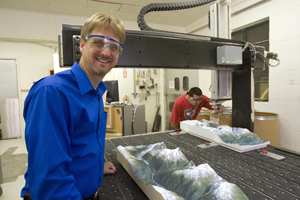
Detailed three-dimensional terrain models made by Solid Terrain Modeling Inc. can be found in visitor centers at state parks and national forests, and even at the Washington, D.C., headquarters of the National Geographic Society.
They’re not just for nature lovers, though. The Department of Defense has been one of the company’s biggest customers, using the models to strategize, train troops, and plan transportation routes through valleys and mountain ranges.
But Pentagon budget cuts are threatening that chunk of the Fillmore company’s sales, so Solid Terrain is opening a Washington-area office to try to keep its military business on terra firma.
“We need to drive the business in the military sector,” said Mark Fisher, chief executive of Solid Terrain. “Before now, we’ve never had a direct presence in Washington or had the ability to have someone focus just on the military.”
Solid Terrain used to license its three-dimensional map-making technology to a Washington-area contractor, but that company – Fisher said he could not disclose the name – got out of the model-making business this year because of defense budget cuts. That left Solid Terrain with no outpost there.
Because the company had done much of its federal business through the contractor, Fisher said many federal customers might not know Solid Terrain by name or that its 3-D maps are still available. And potential customers might believe physical models are passé, instead favoring digital presentations or web-based map programs such as Google Earth.
But Fisher said he believes there’s a big government and military market for his maps because they provide more information than digital tools can. In May, Solid Terrain hired a sales representative in Virginia, and since last month, Fisher said that he’s been searching for office space near Arlington.
The goal is to hold on to military and government customers, as well as to introduce Solid Terrain’s products – and the benefits of physical models – to more federal agencies, such as the Bureau of Land Management.
“We’ve been selling to the government almost since day one, but it’s difficult to make everybody aware we’re here,” Fisher said. “This is ultimately a marketing problem for us.”
Model making
Solid Terrain was founded in 2000 by three former employees of a software company in Moorpark, south of Fillmore. They designed and built two custom machines: one that carves blocks of dense foam into three-dimensional terrain models using digital land survey information, and another that prints images – usually maps or aerial photos – onto the 3-D models.
Fisher said Solid Terrain is the only maker of 3-D terrain maps that doesn’t paint by hand, making its products more detailed and accurate.
The company’s biggest market has always been museums and parks, which display Solid Terrain’s maps in exhibition halls and visitor centers. Its models have also been used by municipal planners, mining companies and developers to show how a project fits into the landscape.
But the military is Solid Terrain’s second biggest market. To keep that business going, Fisher hired Washington sales representative Jose Moreno, who retired from the Marine Corps last year and briefly worked for Solid Terrain’s Washington-area contractor.
Moreno said 3-D models are valuable tools for training troops and planning operations, providing lots of information at a glance and allowing viewers to draw their own conclusions.
“You’re not limited to what a terrain analyst or a computer program tells you,” he said. “It offers the user a large picture of what’s going on. You can make your own judgments.”
On the civilian side, Moreno said his goal is to grow sales by introducing Solid Terrain to any federal agency that might have a use for the company’s 3-D maps and developing relationships with agencies that have purchased maps before, such as the National Park Service. On the military side, he’s hoping to maintain the status quo.
“We’re investing to keep what we have,” he said.
But opening a Washington office at a time when government spending is declining isn’t a sure bet, especially where defense contracting is concerned. Nancy Moore, a management scientist with Santa Monica research and consulting company Rand Corp., said it’s hard to say where the Pentagon will cut.
“We don’t know the details as far as the things they are and aren’t going to buy,” she said. “There’s a lot of uncertainty.”
She noted, though, that Solid Terrain could have an advantage over other companies because government contracting rules favor small businesses. Solid Terrain has just 10 employees and annual revenue between $1 million and $3 million, Fisher said.
He acknowledged that the company gets some of its government contracts thanks to small-business programs, but he also said Solid Terrain has built a reputation for creating accurate, quality products. And while he’s concerned about budget cuts, he believes there is still a big market for Solid Terrain’s maps, which aren’t so expensive that they draw much budget scrutiny. A typical 4-foot-by-8-foot map costs between $10,000 and $20,000, depending on complexity.
“The indication I have from customers is that there’s still a need and still budgets available to procure our product,” Fisher said. “In some cases, we’re kind of flying under the budget radar.”
